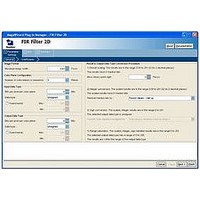IPSR-VIDEO Altera, IPSR-VIDEO Datasheet - Page 87

IPSR-VIDEO
Manufacturer Part Number
IPSR-VIDEO
Description
RENEWAL Of IPS-VIDEO
Manufacturer
Altera
Series
IP Suitesr
Datasheet
1.IPS-VIDEO.pdf
(202 pages)
Specifications of IPSR-VIDEO
Software Application
IP CORE, SUITES
Supported Families
Arria GX, Cyclone II, HardCopy II, Stratix II
Features
Common Avalon Streaming (Avalon-St) Interface And Avalon-St Video Protocol
Core Architecture
FPGA
Core Sub-architecture
Arria, Cyclone, Stratix
Rohs Compliant
NA
Lead Free Status / RoHS Status
na
- Current page: 87 of 202
- Download datasheet (6Mb)
Chapter 5: Functional Descriptions
Chroma Resampler
January 2011 Altera Corporation
f
To get the best results when down-scaling, you can apply a filter to remove high-
frequency data and thus avoid possible aliasing. The filtered algorithm for horizontal
subsampling uses a 9-tap filter with a fixed set of coefficients.
The coefficients are based on a Lanczos-2 function
Coefficients” on page
form is known as the Turkowski Decimator.
For more information about the Turkowski Decimator, refer to Ken Turkowski. Graphics
Gems, chapter Filters for common resampling tasks, pages 147–165. Academic Press
Professional, Inc., San Diego, CA, USA, 1990.
The coefficients are fixed and approximate to powers of two, therefore they can be
implemented by bit-shifts and additions. This algorithm efficiently eliminates aliasing
in the chroma channels, and uses no memory or multipliers. However, it does use
more logic area than the nearest-neighbor algorithm.
4:2:2 to 4:4:4
The nearest-neighbor algorithm is the simplest way to up-scale the chroma channels.
It works by simply duplicating each incoming Cb and Cr sample to fill in the missing
data. This algorithm is very fast and cheap but it tends to produce sharp jagged edges
in the chroma channels.
The filtered algorithm uses the same method as the Scaler MegaCore function would
use for upscaling, that is a four-tap filter with Lanczos-2 coefficients. Use this filter
with a phase offset of 0 for the odd output columns (those with existing data) and an
offset of one-half for the even columns (those without direct input data). A filter with
phase offset 0 has no effect, so the function implements it as a pass-through filter. A
filter with phase offset of one-half interpolates the missing values and has fixed
coefficients that bit-shifts and additions implement.
This algorithm performs suitable upsampling and uses no memory or multipliers. It
uses more logic elements than the nearest-neighbor algorithm and is not the highest
quality available.
The best image quality for upsampling is obtained by using the filtered algorithm
with luma-adaptive mode enabled. This mode looks at the luma channel during
interpolation and uses this to detect edges. Edges in the luma channel make
appropriate phase-shifts in the interpolation coefficients for the chroma channels.
Figure 5–2 on page 5–8
account of the luma, the interpolation to produce chroma values for sample 4 would
weight samples 3 and 5 equally. From the luma, you can see that sample 4 falls on an
the low side of an edge, so sample 5 is more significant than sample 3.
The luma-adaptive mode looks for such situations and chooses how to adjust the
interpolation filter. From phase 0, it can shift to -1/4, 0, or 1/4; from phase 1/2, it can
shift to 1/4, 1/2, or 3/4. This makes the interpolated chroma samples line up better
with edges in the luma channel and is particularly noticeable for bold synthetic edges
such as text.
5–58) that the Scaler MegaCore function uses. Their quantized
shows 4:2:2 data at an edge transition. Without taking any
(“Choosing and Loading
Video and Image Processing Suite User Guide
5–7
Related parts for IPSR-VIDEO
Image
Part Number
Description
Manufacturer
Datasheet
Request
R

Part Number:
Description:
CYCLONE II STARTER KIT EP2C20N
Manufacturer:
Altera
Datasheet:

Part Number:
Description:
CPLD, EP610 Family, ECMOS Process, 300 Gates, 16 Macro Cells, 16 Reg., 16 User I/Os, 5V Supply, 35 Speed Grade, 24DIP
Manufacturer:
Altera Corporation
Datasheet:

Part Number:
Description:
CPLD, EP610 Family, ECMOS Process, 300 Gates, 16 Macro Cells, 16 Reg., 16 User I/Os, 5V Supply, 15 Speed Grade, 24DIP
Manufacturer:
Altera Corporation
Datasheet:

Part Number:
Description:
Manufacturer:
Altera Corporation
Datasheet:

Part Number:
Description:
CPLD, EP610 Family, ECMOS Process, 300 Gates, 16 Macro Cells, 16 Reg., 16 User I/Os, 5V Supply, 30 Speed Grade, 24DIP
Manufacturer:
Altera Corporation
Datasheet:

Part Number:
Description:
High-performance, low-power erasable programmable logic devices with 8 macrocells, 10ns
Manufacturer:
Altera Corporation
Datasheet:

Part Number:
Description:
High-performance, low-power erasable programmable logic devices with 8 macrocells, 7ns
Manufacturer:
Altera Corporation
Datasheet:

Part Number:
Description:
Classic EPLD
Manufacturer:
Altera Corporation
Datasheet:

Part Number:
Description:
High-performance, low-power erasable programmable logic devices with 8 macrocells, 10ns
Manufacturer:
Altera Corporation
Datasheet:

Part Number:
Description:
Manufacturer:
Altera Corporation
Datasheet:

Part Number:
Description:
Manufacturer:
Altera Corporation
Datasheet:











